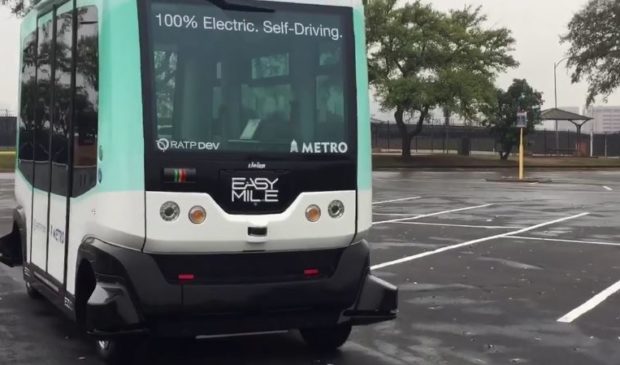Capital Metro demos robot bus
Monday, March 20, 2017 by
Caleb Pritchard The Capital Metropolitan Transportation Authority showed off a robot minibus last week that could be the future of linking low-density areas to the agency’s mass transit network.
Along with RATP Dev, the parent company of Capital Metro contractor McDonald Transit Associates, the agency demonstrated a single Easymile EZ10 self-driving shuttle in a University of Texas parking lot last Thursday and Friday.
The electric vehicle is capable of carrying up to 12 passengers and reaching speeds of 25 miles per hour.
“If we were to acquire these in the future, which we’re talking years from now because of policies and approvals that would have to be in place, we are looking at putting them in our Mobility Innovation Zones,” Capital Metro spokesperson Mariette Hummel told the Austin Monitor, referring to the areas that will lose fixed-route bus service under the agency’s long-term service plan known as Connections 2025. She added, “It’s just one of the options that we’re looking at there.”
Connections 2025, approved by the Capital Metro Board of Directors last month, envisions the reduction of inefficient bus lines, particularly in west and Southwest Austin. Backlash over those proposed cuts pushed the agency’s planners to include accommodations for the Mobility Innovation Zones. Each one will feature tailored transit solutions, though specific proposals have yet to be outlined. In addition to the EZ10, other options include small electric shuttles and partnerships with transportation network companies.
Ironically, Capital Metro demonstrated the self-driving minibus on Friday, which according to an agency tweet also happened to be Transit Operator Appreciation Day.
“An autonomous vehicle like this could potentially, if the technology develops in a couple of years, could be a cost effective way to get people from those low-density areas to our buses and to our rail,” Hummel explained. “So in that sense, it’s not replacing operators at this point. It’s bringing in more potential riders.”
The self-driving EZ10 may seem like a piece of science fiction, but dozens of transit agencies and services across the globe are already utilizing the technology. For the most part, it is deployed on college campuses or in business parks. In most cases, they do not operate in mixed traffic with other cars.
When asked what the barriers are to that level of service, operation engineer Vasilis Karavidas said simply, “The law.”
As for costs, the EZ10’s price tag is a hefty $250,000.
The Austin Monitor’s work is made possible by donations from the community. Though our reporting covers donors from time to time, we are careful to keep business and editorial efforts separate while maintaining transparency. A complete list of donors is available here, and our code of ethics is explained here.
You're a community leader
And we’re honored you look to us for serious, in-depth news. You know a strong community needs local and dedicated watchdog reporting. We’re here for you and that won’t change. Now will you take the powerful next step and support our nonprofit news organization?








